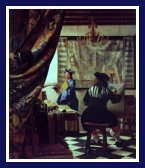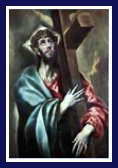Art Enrichment Presentation Descriptions
American Artists
1. The Three Wyeth Generations ... This 4-6-part program details the fascinating lives of the three Wyeth generations: Nowell Convers, Andrew, and Jamie. Their life styles, divergent artistic approaches, and their relationships with each other make this series informative and entertaining.
2. USA’s Illustrator: Norman Rockwell ... Norman Rockwell left an historical legacy in art. He recorded the history of the USA from the days of the horse and buggy through the landing on the moon. He painted famous Americans such as: Albert Einstein, Dwight D. Eisenhower, John K. Kennedy, and Ronald W. Reagan. This is a study of Rockwell's patriotism and the charming but honest way he viewed the 20th century.
3. Powers and Peace: Winslow Homer ... New England’s Winslow Homer was a master watercolor and oil artist. He was an avowed loner, yet his paintings offer opportunities for the world to enjoy the magnitude of the sea, the majesty of the mountains, and the color-filled sunshine of the tropics. Homer's art presented early America as no artist had done before him.
4. Similes of Solitude: Edward Hopper ... Edward Hopper’s work is notable for its emptiness, stillness, starkness, and quiet. Within seemingly noiseless spaces, where economy of shapes and form rule, there is much happening. Enjoying this complex man and his art is an intriguing voyage into his time and thoughts.
5. Small Things Made Great: Georgia O’Keeffe ... As a young art teacher in western Texas, Georgia O’Keeffe spent many evenings walking the plains and drinking in the magic of the vastness of space. She studied the shapes of bones and found mystery and in the smallest flower, the tiniest shell. Her artistic expressions set new directions for 20th century art. O’Keeffe’s brush gave/gives viewers a new way to appreciate the world.
6. Pennsylvania’s Own: Charles Demuth ... A severe diabetic, 20th century painter Charles Demuth was only the second person in history to try the new drug "insulin” to control the disease. As a result, his life was extended 13 years, all of which he lived in Lancaster, Pennsylvania, USA. His detailed impressions in various media are fascinating records of his travels abroad and along the eastern coast of the USA.
7. Ageless is Good: Grandma Moses ... Grandma Moses’ art career “took off” when she was in her 70’s. She arrived quite by accident on the art world’s scene at a time when people were desperately in need of lightness and gaiety toward the end of the 1930’s and the years of depression. Her simple rural life style and naive contributions to art are charming studies.
8. Midwestern Regionalist: Grant Wood ... He was born in Anamosa, Iowa, USA in 1891. He is best known for a painting of his sister and dentist called American Gothic. Grant Wood taught school for several years after his stint in World War I. Then he struck out on his own to become one of America's finest regional artists in the 20th Century. His open, clean, crisp interpretations of life around him are refreshing to study and mirrors into history.

Christiana's World by Andrew Wyeth is featured in "The Three Wyeth Generations" series.
French Impressionism and Post-Impressionism
9. The Roots of Impressionism ... The influences of photographers Mathew Brady and Dorthea Lange, as well as the industrial revolution and the opening of trade routes with the Far East, come together in this discussion about how art was created and perceived in the mid-19th Century. References are made to the founders of Impressionism and the lecture includes overview samples of their work.
10. Art’s Impressionist Leader: Edvard Manet ... By his independent example the Frenchman, Edvard Monet encouraged others to approach artistic expression with a new boldness. His creative path and his preference for the high style in life make for an interesting and informative presentation.
11. Shimmering Light: Claude Monet ... Quite by accident an early work by this French artist gave the Impressionism movement its name. Repeating a subject over and over was Claude Monet’s way of studying the effects of shimmering light and color on form. His haystacks and water lily paintings are among some of the world’s favorites.
12. Beauties and Happiness: Renoir ... He adored beautiful women, tender children, and the enchantment of nature. Historians avow that he never painted an unhappy scene. His “calling cards to heaven” were his two last works … a bouquet of flowers and fruit brought to him by his grandson. Despite his crippling arthritis, the study of Renoir is a study in the joy of living,
13. Dancers and Drama: Edward Degas ... Always the aristocrat, Edgar Degas refused to paint out-of-doors because, “Painting is not a sport.” He considered women to be amazing machines, the same as racehorses. Although he did not find the company of women especially pleasant ... with their ghastly perfumes ... his beautiful paintings and sketches of ballet dancers, racehorses, and bathers all speak to his talent to show the elegance in graceful motion.
14. A Lovely Legacy: Mary Cassatt ... Philadelphia, Pennsylvania’s Mary Cassatt is America’s “French” Impressionist of the 1800’s. She lived out her life in France as an ex-patriot because her father destained her decision to follow a career in painting. She never married, but once said that she "left a family of children" … those she portrayed so sensitively on her canvases and sketchpads. Beautiful women and happy children are her legacy.
15. The “Noble” One: Toulouse-Lautrec ... By lineage, Henri de Toulouse-Lautrec was the only “nobleman” in the midst of the French Post-Impressionists. His sadness was his inherited birth defect that kept his legs from fully maturing. His joys were found in the brothels, cabarets, and circuses of Paris. His brief life was a shambles, but his artistic gifts are treasures.
16. Sorrows and Sympathy: Van Gogh ... Vincent Van Gogh signed his first name to his paintings, to show he was your friend. Mentally unstable and on a continual search for love and respect, his life was doomed from the start, but he painted until the very end. Many times he completed three paintings in a day, only to have sold only one during his life. Today his work is nearly priceless.
17. Exotic and Alone: Paul Gauguin ... Aloof and a loner, the islands of the South Pacific called to Paul Gauguin and would not let him go. He left his family and friends for Tahiti, but he also left footprints in the island sand. Today others still follow his path to the bold handling of flashing colors and shapes.
18. Seeing with more than the Eye: Paul Cezanne ... Paul Cezanne inadvertently heralded the movement called Cubism by showing more than one side of a form at once. He, like Monet, was contented to repeat the same subject on his canvases over and over again. His colorful mountain scenes and landscapes are as magical as his still life paintings are intriguing.

Still life paintings by Paul Cezanne are featured in the lecture "Seeing with more than the Eye."
Other Artists of Note 19. The Magic Brush of Henri Rousseau ... Retired customs officer, Henri Rousseau painted first for pleasure and then became fascinated with the imagery in his world of fantasy. His colorful paintings are primitive in their portrayals, but absorbing in their subject matter and interpretations. To study Rousseau is to enjoy the worlds of the exotic and dreams. 20. The Challenges of Marc Chagall ... Born in Vitebsk, Lithuania, Marc Chagall lived through two World Wars and the Russian Revolution. As a Jew persecuted in his own homeland, he rejoiced to see the establishment of Israel. The despair in his challenging life only reached his canvases once … when his beloved wife died in 1943. Chagall’s imaginative works are a fascinating study. 21. The Northern Light: Edvard Munch ... Norway’s most famous artist is Edvard Munch. The loss of his mother and favorite sister at a young age severely impressed Munch. He saw his life as sad and filled with gloom and sorrow. His absorbing, telltale, artistic expressions reflect his efforts to better understand himself and the world around him. 24. Michelangelo’s Triumphs ... After Michelangelo, art was never the same. This 3-6-part series explores the giant’s Sistine Chapel ceiling and altar wall, and five of his sculptures. Also included is background on the artist's life and loves, and selections from some of Michelangelo’s beautiful revealing poetry.
22. Secrets in Silence: Jan Vermeer ... Dutchman, Jan Vermeer painted special moments in the lives of the people he knew in Delft. His seemingly silent canvases which are primarily interior studies, dance with secret messages.. Although his output was relatively small, his lovely organized compositions are hallmarks in the world of art history.
23. Understanding Rembrandt ... Rembrandt van Rijn lived both a joy-filled and sorrow-filled life. First in high demand, his fickle public slipped through his fingers as a result of vicious, unfounded rumors. Bereft at the loss of nearly all of those closest to him, he continued to create, perhaps was a way to understand his life’s fate. His sketches, prints, and paintings reveal the heart of this sensitive Dutchman.
25. Leonardo Da Vinci’s Masterpieces ... This 1-2-part program features the amazing genius of Leonardo Da Vinci. Discussion of this Italian’s multi-faceted life and the incredible ideas he pre-imagined fast-forwards him into day’s world. The Last Supper, and The Mona Lisa are the art appreciation focuses.

The Art of Painting is a work by Jan Vermeer and featured in the lecture "Secrets in Silence."
26-31. The Spanish artists: El Greco
Diego Velazquez
Francisco Goya
Pablo Picasso
Juan Gris
Salvador Dali
The final presentation package for the above artists (numbers: 26-31) is in production. Watch for individual offerings of all five artists to become available within the next few months.

Paintings like this one called Christ with the Cross by El Greco will be featured in an up-coming presentation.